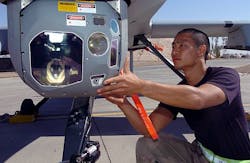Navy researchers name three companies to prototype advanced surveillance sensors
CRANE, Ind., 19 Oct. 2015. U.S. Navy researchers are working with three U.S. technology companies to develop advanced sensors for intelligence, surveillance, reconnaissance, and force-protection applications.
Officials of the Naval Surface Warfare Center Crane Division in Crane, Ind., have announced potential $49 million contracts to the three companies for prototypes of advanced sensors and sensor systems in support of intelligence, surveillance, reconnaissance, and force-protection missions.
The three companies are:
Consolidated Resource Imaging LLC in Grand Rapids, Mich.;
Manufacturing Techniques Inc. (MTEQ) in Kilmarnock, Va.; and
Northrop Grumman Xetron in Cincinnati.
Related: U.S. demand for ISR technology shifting from military to counter-terrorism, analysts say
Consolidated Resource Imaging, MTEQ, and Northrop Grumman Xetron will have the opportunity to propose on individual delivery orders for prototypes of advanced sensors and sensor systems supporting various customers, Navy officials say.
Each of the three contractors will receive $2,500 up-front, and over the next five years will compete for separate delivery orders based on their proposals for sensor prototypes. The contracts to the three companies are for one year and have four one-year options.
Consolidated Resource Imaging specializes in airborne intelligence, surveillance and reconnaissance (ISR) development, integration, test, evaluation, deployment, and analysis, and fields advanced ISR technologies. The company has experience in aerial cinematography, airborne imagery stabilization, data processing, data storage, analysis, dissemination, systems integration, and flight operations.
Related: Raytheon to provide UAV electro-optical targeting systems in $50.2 million contract
MTEQ designs and develops prototype sensors and systems, as well as provides advanced sensor and systems design support for the U.S. Department of Defense (DOD), intelligence, and law-enforcement agencies.
Northrop Grumman Xetron provides the Xetron Computer Cosite Model (XCCM) allows for the evaluation of cosite mitigation techniques using computerized modeling rather than field testing. The XCCM can evaluate the performance of communications systems, and isolate performance and dominant interference causes to assess and design radio systems that operate with efficiency in a severe cosite environment.
For more information contact the Naval Surface Warfare Center-Crane at www.navsea.navy.mil/Home/WarfareCenters/NSWCCrane.

